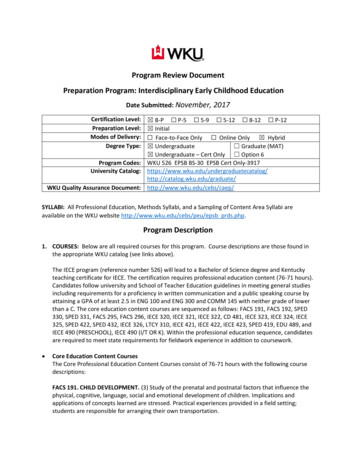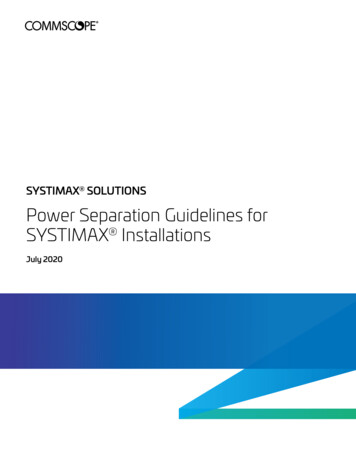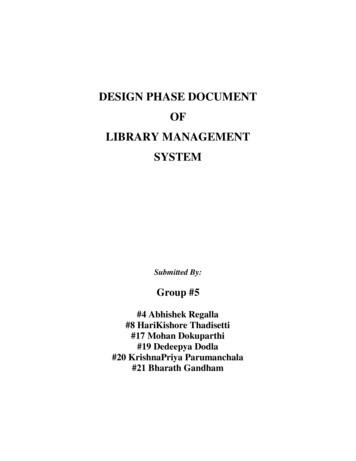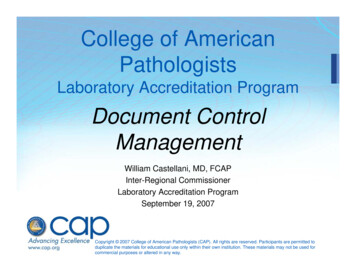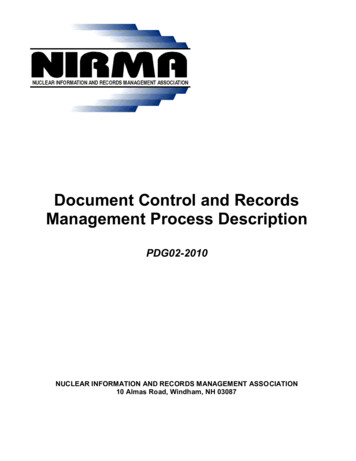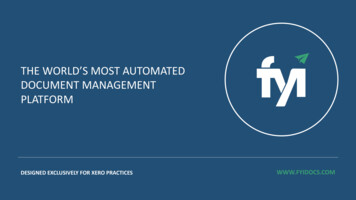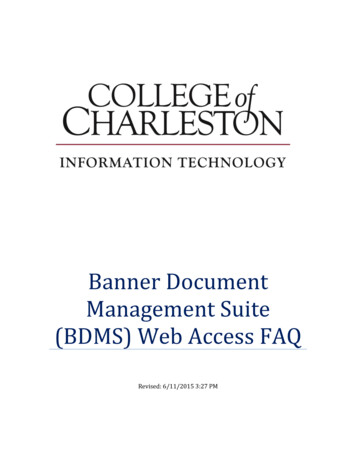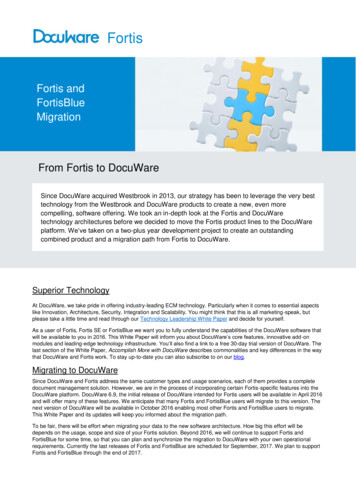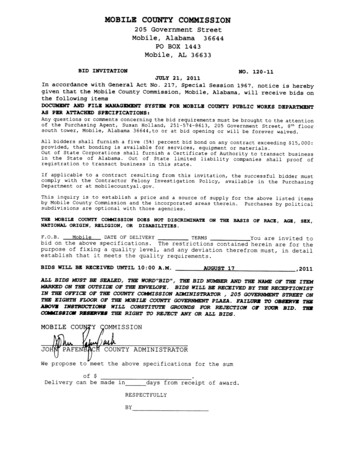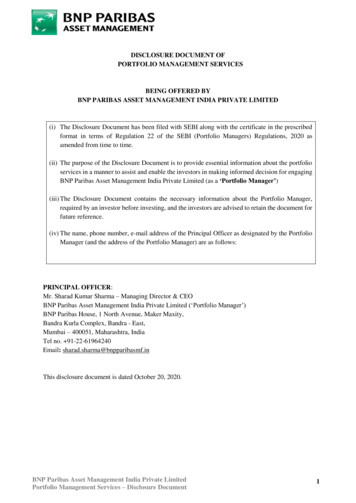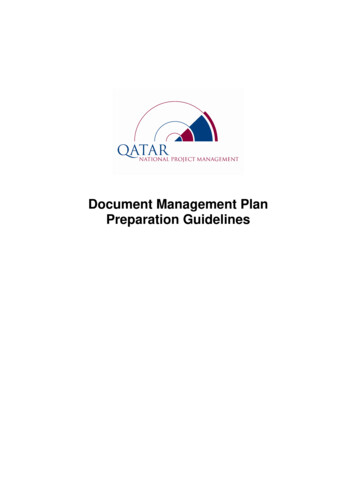
Transcription
Document Management PlanPreparation Guidelines
TABLE OF CONTENTS1.Purpose of Document 12.Definition of Document Management 13.Objectives of Document Management 14.Terms, Acronyms and Abbreviations 15.Document Management Methods 15.1Document Templates.25.2Document Storage .35.3Document Recovery and Backup .35.4Document Security .45.5Document and Media Destruction .55.6Document Approval .56.Roles and Responsibilities 6Appendix A: Document Control Sheet 7Document Management Plan – Preparation GuidelinesTable of Contents
1.PURPOSE OF DOCUMENTNote: This document does not cover all the elements of Configuration Management required for technologyprojects. Note also that it does not describe or assume use of document management software.Instruction:This section provides the purpose of the document.Recommended text:The purpose of this document is to outline the document management approach for insert name of project It provides standard terminology, clear roles and responsibilities, and a detailed description of expectations ofteam members regarding document control. It is designed to guide the project team.2.DEFINITION OF DOCUMENT MANAGEMENTRecommended Text:Documents refer to all project records and deliverables. Document management is the process of organizing,storing, protecting, and sharing documents.3.OBJECTIVES OF DOCUMENT MANAGEMENTRecommended Text:The overall goal of document management is to protect a project from losing track of its work or losing the workitself.Document management achieves this overall goal through the following objectives: Provide safe storage and backup of all documents in a project library. Provide clarity regarding which version of a deliverable is the latest version. Provide a clear record of approved deliverables over the life of the project. Provide measures to maintain restricted access to confidential documents. Provide an accurate and complete archive of project documents to the permanent organization at theend of the project.4.TERMS, ACRONYMS AND ABBREVIATIONSRecommended Text:All terms, acronyms, and abbreviations used in this document are defined in the Project Management Glossaryat www.qnpm.gov.qa.5.DOCUMENT MANAGEMENT METHODSRecommended Text:This section describes the methods used to control project documents. These include templates, namingconventions, storage, recovery and backup, security, destruction, and approval.Tips:Remember that once a Plan is approved, the project must undertake the document management process andmethods described in this document. The Project Manager should be held accountable for completing activitiesdescribed in this Plan by the Sponsor.Document Management Plan – Preparation GuidelinesPage 1
This document should describe the nature and extent of document management activities for a specific project.Avoid providing general descriptions of document management best practice.5.1Document TemplatesRecommended Text:What follows is a listing of document templates team members are expected to use and a description of the keyelements of deliverable templates for document control purposes.5.1.1Listing of TemplatesRecommended Text:What follows is a listing of templates and the software and version they use. All team members are expected touse these templates to promote consistency in how team members present work to each other and to theoutside world. Team members are also expected to use the software versions listed below to avoid problemssharing documents with other team members.All templates are provided on a CDROM to team members at orientation, and copies are available to teammembers on the project server.Example table for listing templates:Template NameDescriptionSoftware and VersionPresentationsA standard document for preparing presentationsPowerPoint insert version Deliverable DocumentsA standard document for preparing writtendeliverables such as plans and reportsWord insert version Meeting AgendaA format for presenting meeting agendasWord insert version Meeting MinutesA format for presenting meeting minutesWord insert version Status ReportA format for each team to report status to the ProjectManagerWord insert version ScheduleThe expected format for schedules, includingguidelines for level of detail and organization of workpackagesQNPM Tool (Primavera) insert version 5.1.2Key Components of TemplatesRecommended Text:Key elements of templates for document control purposes are as follows:ElementDocument StatusDescriptionTwo types:LocationFront pageDraft: Under development or revisionFinal: ApprovedConfidentiality LevelThree types:Front page and footerConfidential: restricted circulationInternal: circulation within projectPublic: no restrictions on circulationCopyrightStandard language regarding ownership ofmaterialFirst pageAuthorsListing of contributing authors and contactinformationDocument control page after titlepageVersion HistoryListing of version numbers and who was involvedin creating each versionDocument control page after titlepageDocument Management Plan – Preparation GuidelinesPage 2
ElementApprovalsDescriptionRecord of the approved version with signatureLocationDocument control page after titlepage5.1.3 Document Naming ConventionsExample naming convention:The standard format for a document file name is as follows: Document Status Deliverable Name Document Version Number initials of author or revisor Example:Draft Document Management Plan v2 MLFinal Strategic Plan v7 KANote: The example above is a straightforward naming convention. Some projects may choose to specifynaming conventions for different types of documents and apply a numbering system to deliverables with uniqueidentifiers.5.2Document StorageTips:This section outlines where and how documents will be stored. Team members should not store work on theirdesktops, laptops, or other computers for long periods of time as this makes work vulnerable to loss fromaccidents, viruses, and employee turnover.Items to consider when writing this section are as follows: How frequently should team members put copies of their work in a safe storage place? Are all team members in one location? If no, how will team members working on the same deliverablestore and share versions? Which team members should have access to which files? Will the library be electronic only, or will a hard copy library also be created? How should the project file directory be organized? By team? By deliverable?Example section:All team members are expected to put electronic copies of their work in the project directory on the projectserver at the end of each working week using the document naming conventions provided above. A directoryhas been established on the project server, and team members have limited access to different files on thisserver based on their role.Team members are also expected to provide hardcopies of approved deliverables with signatures to the ProjectManager for inclusion in a central hardcopy library.5.3Document Recovery and BackupRecommended Text:The purpose of backup is to allow recovery after a mishap. The first stage of the recovery process must be theanalysis of what needs to be restored. Once the extent of what needs to be restored has been determined,recovery action can commence by loading the last full weekly backup followed by the last incremental backup.Tip:For important and time critical data, a mirror system, or at least a mirror disk may needed for a quick recovery.Example section:This section outlines the recommended document backup and recovery procedure for documents.Document Management Plan – Preparation GuidelinesPage 3
Backups should conform to the following best practice procedures: All files must be adequately and systematically backed up including updates. Records of what is backed up and to where must be maintained. The backup media must be precisely labelled, and accurate records must be maintained of thosebackups completed. Copies of the backup media, together with the backup record, should be stored safely in a remotelocation. Regular tests of restoring data/software from the backup copies should be undertaken, to ensure thatthey can be relied upon for use in an emergency.TypeDescriptionFrequencyStorage LocationRemote BackupAs the name implies, the full monthlybackup takes a copy of all files,libraries, and data. The size of a fullbackup can be large, and the time ittakes to complete could impactservice availability if not carefullyplanned.MonthlyRemote secure locationFull BackupAs the name implies, the full backuptakes a copy of all files, libraries, anddata.WeeklyFirebox (Local)IncrementalThe incremental backup uses the FullBackup as a starting point and makesbackup copies of data that haschanged since the previous backupwas taken. In most cases the use ofincremental backups radically reducesthe time taken to do the backups. Itmay require some backupmanagement softwareDailyFirebox (Local)5.4Document SecurityRecommended Text:This section outlines procedures for keeping documents secure for insert project name .The requirements for documents security varies depending on the scale, the sensitivity or importance of theinformation and activities supported. However the security measures outlined below should be followed:5.4.1 ConfidentialityDocument authors are responsible for setting the level of document confidentiality based on guidelines providedby the Project Manager.The levels are as follows: Confidential: restricted circulation Internal: circulation within project Public: no restrictions on circulation5.4.2 Clear Desk PolicyAll document users should adopt a “Clear Desk Policy” for confidential and sensitive papers, electronic storagemedia and other assets to reduce the risk of unauthorised access, theft or damage outside normal workinghours.Where appropriate the following should be considered: Sensitive and confidential documents should be locked in cabinets when not in use. Sensitive information, laptops, personal digital assistants, and other valuable items should be lockedaway when not in use. All documents should be stored on the central storage device (server).Document Management Plan – Preparation GuidelinesPage 4
5.4.3 Removal of DocumentsSensitive and confidential documents on any form of electronic media must not be taken off-site withoutappropriate authorisation from the information owner or systems owner.Authorization should only be provided to staff with remote access and staff with permission to work from home.5.4.4 Equipment Security GuidelinesEquipment should be physically protected from security threats and environmental hazards to both reduce therisk of unauthorised access to data and to safeguard against loss or damage.The following checklist may be used to identify potential hazards; Fire Smoke Water and other liquids Dust Vibration Chemical effects Electrical supply interference Electromagnetic radiation Theft Smoking, eating and drinking should be prohibited in computer areas5.4.5 Virus ControlsVirus detection and prevention measures and appropriate user awareness procedures should be implemented.Users should be reminded that prevention is far better than cure. The basis of protection against viruses shouldbe founded on good security awareness, appropriate system access controls, and the following specificguidelines: Virus-specific detection software (which must be regularly updated and used as directed by the supplier)should be used to scan computers and media for known viruses as a precautionary measure and on aroutine basis. Change detection software should be installed on computers, where appropriate, to detect any changein executable code. Virus “repair” software should be used with caution, and only in cases where virus characteristics arefully understood and the correct repair is certain. Any diskettes or CDs of uncertain or unauthorized origin should be checked for viruses before use.5.5Document and Media DestructionRecommended Text:All documents containing information that has been classified as “confidential” or “internal” by their authors orthe Project Manager must be shredded (using a shredder) prior to being discarded.Any computer hard drive or removable magnetic medium, such as a diskette, magnetic tape, Zip disk, etc., thathas been used to hold any kind of “confidential” or “internal ” information must be electronically “scrubbed” priorto being discarded or being transferred to any individual or entity who is not authorized to view such information.On such media, the mere deletion of confidential data is not sufficient as deleted information is still accessibleto individuals possessing a number of software tools. Any non-erasable medium, such as a CD, optical disk,etc., that has been used to hold any kind of “confidential” or “internal” information must be physically destroyedbefore being discarded.5.6Document ApprovalRecommended Text:All documents requiring Sponsor approval must go through a compliance review and technical review by theProject Manager before going to the Project Sponsor for review. The compliance review checks whether or notDocument Management Plan – Preparation GuidelinesPage 5
the document complies with the template and matches the deliverable description provided in the Project Plan.The technical review involves the Project Manager reviewing the content for quality.Once necessary changes arising from the compliance and technical review are made, the Project Managerprovides the document to the Sponsor for review and approval.The Project Manager’s compliance and technical review should be completed in five business days. Sponsorapproval is expected to take ten business days.6.ROLES AND RESPONSIBILITIESRecommended Text:This section outlines roles and responsibilities for everyone involved in the document management process.This section should only include document management-related responsibilities, and it should contain moredetail on document management responsibilities than provided in the Project Plan.The table below describes roles and responsibilities related to the risk management process.Document Management Plan – Preparation GuidelinesPage 6
APPENDIX A: DOCUMENT CONTROL SHEETRecommended Text:All project deliverables will have a document control sheet at the beginning to help track versions and approvals.This control sheet lists authors, version history, and approvals as listed below.AUTHORSThis document was prepared by:VERSION HISTORYDateDocumentVersionDocument Revision HistoryDocument Author / ReviserDocumentVersionApprover Name and TitleApprover SignatureAPPROVALSDateDocument Management Plan – Preparation GuidelinesPage 7
Document Management Plan – Preparation Guidelines Page 5 5.4.3 Removal of Documents Sensitive and confidential documents on any form of electronic media must not be taken off-site without appropriate a
